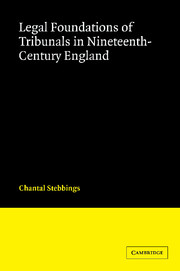Book contents
- Frontmatter
- Contents
- Acknowledgements
- Table of statutes
- Table of cases
- List of abbreviations
- 1 Challenges to the legal process
- 2 The ideological and theoretical context
- 3 Composition and personnel
- 4 Jurisdiction and functional powers
- 5 Procedure and practice
- 6 Judicial supervision
- 7 Principles, place and perception
- Index
4 - Jurisdiction and functional powers
Published online by Cambridge University Press: 02 December 2009
- Frontmatter
- Contents
- Acknowledgements
- Table of statutes
- Table of cases
- List of abbreviations
- 1 Challenges to the legal process
- 2 The ideological and theoretical context
- 3 Composition and personnel
- 4 Jurisdiction and functional powers
- 5 Procedure and practice
- 6 Judicial supervision
- 7 Principles, place and perception
- Index
Summary
The tribunals of the first quarter of the nineteenth century were created in order to implement certain statutory regimes in a variety of spheres of human activity and concern, and were created by the statutes themselves. The nature of their duties was determined by the character of the legislation they were called on to implement and the statutory provision governing their creation, and so by their very nature their duties and functions varied considerably in their detail. However, whether their purpose was to make assessments to tax, to convert tithes to money payments, or copyhold land to freehold land, to value land for the poor rate or to regulate the railways, in principle they were strikingly similar. Their purpose was an administrative one, in the sense of the management of public affairs, and the enabling powers they exercised were largely administrative in nature. In order to execute their predominantly administrative function, it has been seen that there had to be some mechanism whereby any grievances, objections or disputes an individual might have could be raised and settled. When hearing and determining disputes, their function was a judicial one in the sense of resolving disputes on their merits by the establishment of facts and the application to those facts of legal rules. A common feature of these tribunals, therefore, was that they invariably combined functions that are today recognised as essentially administrative in nature with others which were primarily judicial.
- Type
- Chapter
- Information
- Legal Foundations of Tribunals in Nineteenth Century England , pp. 147 - 183Publisher: Cambridge University PressPrint publication year: 2007



